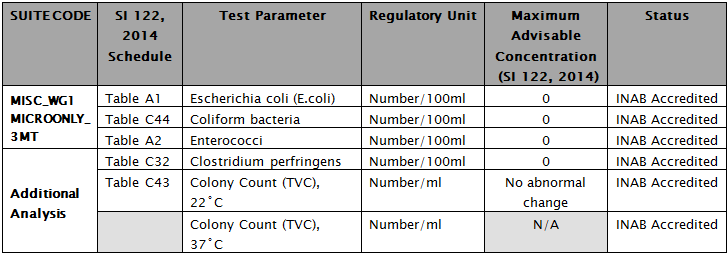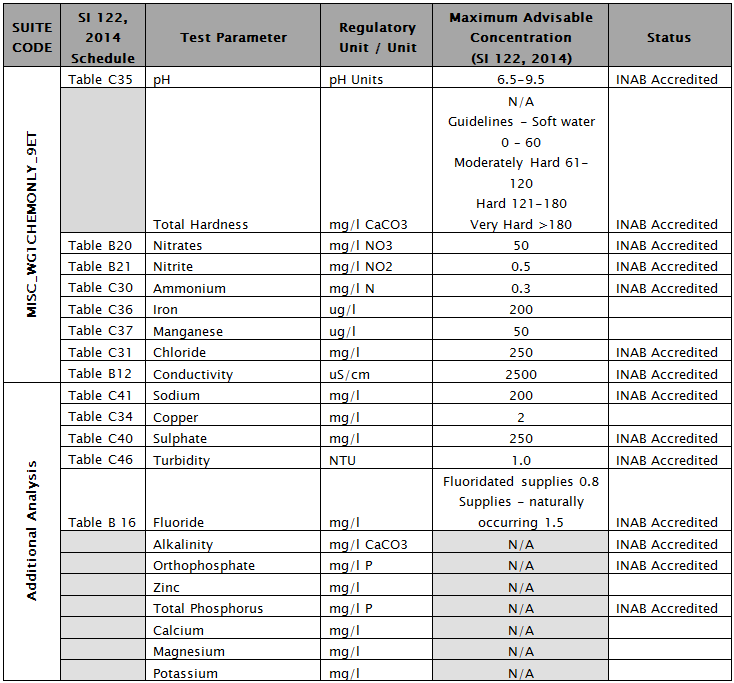How to Interpret Your Water Test Results
Our laboratory is accredited by INAB (Irish National Accreditation Board) Registration no 166T to ISO17025 for the test parameters below applicable to drinking water analysis. We can provide a range of testing services to meet your requirements from general water quality checks to full analysis to assess compliance with Drinking Water Regulations SI122, 2014.
Microbiological testing takes 2-3 days to complete and chemical testing takes 7-10 days. You will receive 2 separate certificate of analysis for your water sample.
Microbiological Analysis:
Chemical Analysis:
Explanation of Microbiological Tests
Total Coliforms/E. coli/Enterococci
Total Coliforms, E. coli and Enterococci are bacteriological terms. Coliforms are a group of bacteria with E. coli being one member of that group. The presence of E. coli or Enterococci in drinking water indicates that the supply has become contaminated with human or animal waste or that the disinfection system is not operating adequately.
All these should be absent from drinking water. Where they are present some stomach sickness may occur. Treatment should be undertaken to remove the bacteria and the water should be boiled for drinking purposes until then.
Explanation of Chemistry Tests
pH
pH is a measure of the intensity of the acidity/alkalinity of water on a scale of 0-14 with 7 being neutral. Low pH (<6.5) results may lead to corrosion of metal pipes and surfaces and a green/blue off colour on ceramic tiles and sinks.
Total Hardness
Hard water is water that has high minerals content (in contrast with “soft water”). Hard water is generally not harmful to one’s health. Levels below 60 ppm = soft water, 60-120 ppm = moderately hard,121 – 180 = hard water and above = >180ppm. Problems occur where the water is too hard and deposits on pipes leaving a white limescale. This can build up over time leading to appliances burning out and pipes being blocked.
Nitrite/ Nitrates/ Ammonia
Nitrates/ Nitrites /Ammonia are founds in nature from many sources, primarily from fertilisers and effluents. For Nitrates where a child is taking water with levels above 50 mg/l for a prolonged period of time a condition known as ‘Blue baby syndrome’ may occur where the child is unable to carry enough blood around its body.
Iron
Iron is a metal widely found in rocks and soils. Water with iron may look clear at first, however upon exposure to air the iron is oxidized to form orange/red insoluble particles. Iron stains plumbing fixtures and laundry a light red/brown colour and causes undesirable tastes.
Manganese
Manganese is a metal widely found in rocks and soils. At levels exceeding 50 ug/l manganese stains plumbing fixtures and laundry a dark brown colour and causes undesirable tastes. Its presence in water may lead to microbial growths in the pipe system. Manganese is essentially nontoxic at levels normally found and only causes health problems at levels where there is a very undesirable taste.
Chlorides
They are usually associated with the salt content and the amount of dissolved minerals in water. The recommended limit for chlorides is 250 milligrams per litre (mg/1).
Conductivity
Conductivity in water is affected by the presence of inorganic dissolved solids such as chloride, nitrate, sulfate, and phosphate anions (ions that carry a negative charge) or sodium, magnesium, calcium, iron, and aluminum cations (ions that carry a positive charge).



